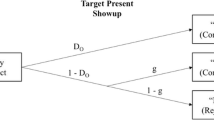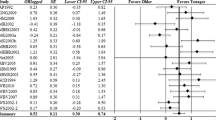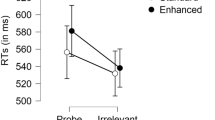Abstract
Objectives
We conducted a meta-analysis to assess whether the construction of facial composites affects witnesses’ lineup identification decisions.
Methods
We located 23 studies (56 effects, 2276 participants). We consider effects of constructing composites on (a) correct identifications, and (b) incorrect identifications, from target-present lineups, and (c) incorrect identifications from target-absent lineups. Log odds ratio effect sizes were entered into a random-effects meta-analysis. We also present novel signal detection theory analyses in an online supplement.
Results
There were no significant negative effects of composite construction, but some weak evidence that composite construction reduced incorrect identifications in target-present lineups. Because effect sizes showed little hetereogeneity for any of the outcomes (after outlier removal), there were no moderator analyses. Results for SDT measures also showed no effects.
Conclusions
Empirical evidence suggests no effects of composite construction on identifications. We identify gaps in knowledge and make recommendations for more ecologically valid research.






Similar content being viewed by others
References
Note: studies with asterisks (*) are included in the meta-analysis.
Attorney General of the State of Wisconsin. (2009). Model policy and procedure for eyewitness identification. Retrieved from http://www.doj.state.wi.us/sites/default/files/2009-news/eyewitness-public-20091105.pdf
Bedillion, C. N. (2017). The effects of the verbal overshadowing effect and independently creating composite sketches on eyewitness identification accuracy. (B.Sc. Thesis), Allegheny College Meadville, Pennsylvania, USA. Retrieved from http://hdl.handle.net/10456/45385
Borenstein, M., Hedges, L. V., Higgins, J. P., & Rothstein, H. R. (2009). Introduction to meta-analysis. Chichester: John Wiley & Sons, Ltd. https://doi.org/10.1002/9780470743386.
Brainerd, C. J. (2005). The science of false memory. In V. F. Reyna (Ed.), Oxford University Press. https://doi.org/10.1093/acprof:oso/9780195154054.001.0001.
Bruce, V. (1982). Changing faces: visual and non-visual coding processes in face recognition. British Journal of Psychology, 73, 105–116. https://doi.org/10.1111/j.2044-8295.1982.tb01795.x.
Clare, J., & Lewandowsky, S. (2004). Verbalizing facial memory: criterion effects in verbal overshadowing. Journal of Experimental Psychology: Learning, Memory, and Cognition, 30(4), 739–755. https://doi.org/10.1037/0278-7393.30.4.739.
Comish, S. E. (1987). Recognition of facial stimuli following an intervening task involving the Identi-kit. Journal of Applied Psychology, 72, 488–491. https://doi.org/10.1037/0021-9010.72.3.488.
Cooper, H. (2010). Research synthesis and meta-analysis. A step-by-step approach. Los Angeles: Sage.
Cooper, H., Hedges, L. V., & Valentine, J. C. (2009). The handbook of research synthesis and meta-analysis. New York: Russel Sage Foundation.
*Davies, G. M., Ellis, H. C., & Shepherd, J. (1978). Face identification: The influence of delay upon accuracy of photofit construction. Journal of Police Science & Administration, 6, 35–42.
Davies, G. M., & Valentine, T. (2007). Facial composites: forensic utility and psychological research. In R. C. L. Lindsay, D. F. Ross, J. D. Read, & M. P. Toglia (Eds.), The handbook of eyewitness psychology, Vol II: memory for people (pp. 59–83). Mahwah: Lawrence Erlbaum Associates Publishers.
Davis, D., & Loftus, E. F. (2007). Internal and external sources of misinformation in adult witness memory. In R. C. L. Lindsay, D. F. Ross, J. D. Read, & M. P. Toglia (Eds.), The handbook of eyewitness psychology, Vol I: memory for events (pp. 195–237). Mahwah: Lawrence Erlbaum Associates Publishers.
*Davis, J. P., Gibson, S., & Solomon, C. (2014). The positive influence of creating a holistic facial composite on video line-up identification. Applied Cognitive Psychology, 28, 634–639. https://doi.org/10.1002/acp.3045.
*Davis, J. P., Thorniley, S., Gibson, S., & Solomon, C. (2016). Holistic facial composite construction and subsequent lineup identification accuracy: comparing adults and children. The Journal of Psychology, 150, 102–118. https://doi.org/10.1080/00223980.2015.1009867.
Deffenbacher, K. A., Bornstein, B. H., McGorty, E. K., & Penrod, S. D. (2008). Forgetting the once-seen face: estimating the strength of an eyewitness’s memory representation. Journal of Experimental Psychology: Applied, 14, 139–150. https://doi.org/10.1037/1076-898x.14.2.139
Deffenbacher, K. A., Bornstein, B. H., & Penrod, S. D. (2006). Mugshot exposure effects: retroactive interference, mugshot commitment, source confusion, and unconscious transference. Law and Human Behavior, 30(3), 287–307. https://doi.org/10.1007/s10979-006-9008-1.
Deffenbacher, K. A., Bornstein, B. H., Penrod, S. D., & McGorty, E. K. (2004). A meta-analytic review of the effects of high stress on eyewitness memory. Law and Human Behavior, 28, 687–706. https://doi.org/10.1007/s10979-004-0565-x.
*Dumbell, E. (2008). Face composite production effects on witness memory: Case not closed. (Unpublished honor's thesis), University of Cape Town.
Duval, S., & Tweedie, R. (2000). Trim and fill: a simple funnel‐plot–based method of testing and adjusting for publication bias in meta‐analysis. Biometrics, 56(2), 455–463. https://doi.org/10.1111/j.0006-341x.2000.00455.x
Fitzgerald, R. J., Price, H. L., Oriet, C., & Charman, S. D. (2013). The effect of suspect-filler similarity on eyewitness identification decisions: a meta-analysis. Psychology, Public Policy, and Law, 19(2), 151–164. https://doi.org/10.1037/a0030618.
Fleiss, J. L., & Berlin, J. A. (2009). Effect sizes for dichotomous data. In H. Cooper, L. V. Hedges, & J. C. Valentine (Eds.), The handbook of research synthesis and meta-analysis (2nd ed., pp. 237–253). New York: Russell Sage.
Franzen, S., & Sporer, S. L. (1994a). Personenverwechslungen durch irrefuehrende Rekonstruktionsbilder: Zum Einfluss nachtraeglicher Informationen und der Wiederherstellung des Wahrnehmungskontextes (Person mixups as a function of misleading composites: on the influence of postevent information and context reinstatement). In S. L. Sporer & D. Meurer & (Eds.), Die Beeinflussbarkeit von Zeugenaussagen (Influencing eyewitness testimony) (pp. 207–236). Marburg: N.G. Elwert.
Franzen, S., & Sporer, S. L. (1994b). Personenverwechslungen und Moeglichkeiten ihrer Vermeidung: Koennen Augenzeugen durch Visualisierung gegen den Einfluss von irrefuehrenden Rekonstruktionsbildern immunisiert werden (Person mixups and possible countermeasures: can eyewitnesses be inoculated against misleading composites through visualization)? In S. L. Sporer & D. Meurer (Eds.), Die Beeinflussbarkeit von Zeugenaussagen (Influencing eyewitness testimony) (pp. 237–283). Marburg: N.G. Elwert.
Frowd, C. D., Valentine, T., & Davis, J. P. (2015). Facial composites and techniques to improve image recognizability. In T. Valentine & J. P. Davis (Eds.), Forensic facial identification: theory and practice of identification from eyewitnesses, composites and CCTV (pp. 43–70). Chichester: Wiley-Blackwell.
Gamer, M., Lemon, J., & Singh, I. F. P. (2017). irr: Various coefficients of interrater reliability and agreement. R package version 0.84. https://CRAN.Rproject.org/package=irr
Garrett, B. (2011). Convicting the innocent. Cambridge: Harvard University Press. https://doi.org/10.4159/harvard.9780674060982.
Garry, M., & Wade, K. A. (2005). Actually, a picture is worth less than 45 words: narratives produce more false memories than photographs do. Psychonomic Bulletin & Review, 12(2), 359–366. https://doi.org/10.3758/bf03196385.
Goodsell, C. A., Neuschatz, J. S., & Gronlund, S. D. (2009). Effects of mugshot commitment on lineup performance in young and older adults. Applied Cognitive Psychology, 23(6), 788–803. https://doi.org/10.1002/acp.1512.
Holland, K., Otzen, H., & Sporer, S. L. (1994). Der Einfluss der Rekonstruktion und der Beschreibung von Gesichtern auf das spätere Wiedererkennen (The influence of constructing a face composite and describing a face on later face recognition). In S. L. Sporer & D. Meurer (Eds.), Die Beeinflussbarkeit von Zeugenaussagen (Influencing eyewitness testimony) (pp. 154–206). Marburg: N. G. Elwert.
Horry, R., Halford, P., Brewer, N., Milne, R., & Bull, R. (2014). Archival analysis of eyewitness identification test outcomes: what can they tell us about eyewitness memory? Law and Human Behavior, 38, 94–108. https://doi.org/10.1037/lhb0000060.
Innocence Project (2018). Eyewitness misidentification. Retrieved August 13, 2018, from https://www.innocenceproject.org/dna-exonerations-in-the-united-states/
Johnson, M. K., Hashtroudi, S., & Lindsay, D. S. (1993). Source monitoring. Psychological Bulletin, 114(1), 3–28. https://doi.org/10.1037/0033-2909.114.1.3.
Junkin, T. (2004). Bloodsworth: the true story of the first death row inmate exonerated by DNA. Chapel Hill: Algonquin.
*Kempen, K. (2009). “It’s the thought that counts”: face composite production can hamper recognition performance. (Unpublished honour’s thesis). University of Cape Town.
*Kempen, K. (2012). “What big teeth you have” – Red riding hood and the face recognition failure: the effects of isolated featural and configural composite construction on recognition accuracy. (Unpublished master’s thesis). University of Cape Town.
Lipsey, M. W., & Wilson, D. B. (2001). Practical meta-analysis. London: Sage Publications.
Loftus, E. F., & Palmer, J. C. (1974). Reconstruction of automobile destruction: an example of the interaction between language and memory. Journal of Verbal Learning and Verbal Behavior, 13(5), 585–589.
Malpass, R. S., Tredoux, C. G., Compo, N. S., McQuiston-Surrett, D., MacLin, O. H., Zimmerman, L. A., & Topp, L. D. (2008). Study space analysis for policy development. Applied Cognitive Psychology, 22(6), 789–801.
*Maskow, M., Schmidt, H., Tredoux, C. G., & Nunez, D. T. (2007). Face composite production does not affect eyewitness identification accuracy. Unpublished manuscript, University of Cape Town.
Mauldin, M. A., & Laughery, K. R. (1981). Composite production effects on subsequent facial recognition. Journal of Applied Psychology, 66, 351–357. https://doi.org/10.1037/0021-9010.66.3.351.
*McClure, K. A., & Shaw, J. S. (2002). Participants’ free-hand drawings of a target face can influence recognition accuracy and the confidence–accuracy correlation. Applied Cognitive Psychology, 16, 387–405. doi:https://doi.org/10.1002/acp.802.
Meissner, C. A., & Brigham, J. C. (2001). A meta-analysis of the verbal overshadowing effect in face identification. Applied Cognitive Psychology, 15, 603–616. https://doi.org/10.1002/acp.728.
Miller, J. (1996). The sampling distribution of d. Perception & Psychophysics, 58, 65–72. https://doi.org/10.3758/bf03205476.
Orwin, R. G., & Vevea, J. L. (2009). Evaluating coding decisions. In H. Cooper, L. V. Hedges, & J. C. Valentine (Eds.), The handbook of research synthesis and meta-analysis (2nd ed., pp. 177–205). New York: Russell Sage.
Pigott, T. D. (2012). Advances in meta-analysis. New York: Springer. https://doi.org/10.1007/978-1-4614-2278-5.
*Pike, G. E., Brace, N. A., Turner, J., & Vredeveldt, A. (2018a). Comparing the effects of feature-based and holistic facial composite systems on eyewitness identification accuracy. Manuscript under review.
*Pike, G. E., Brace, N. A., Turner, J., & Vredeveldt, A. (2018b). The effect of facial composite construction on eyewitness identification accuracy in an ecologically valid paradigm. Criminal Justice and Behavior, Advance online publication. doi:https://doi.org/10.1177/0093854818811376.
R Core Team (2018). R: a language and environment for statistical computing. R Foundation for Statistical Computing, Vienna, Austria. URL https://www.R-project.org/.
Schmidt, H. C., & Tredoux, C. G. (2006). Utilisation and usefulness of face composites in the South African Police Service - an evaluation study. South African Journal of Criminal Justice, 19, 303–314.
Skelton, F. C., Hancock, P. J. B., Jones, H. S., Battersby, K., Fodarella, C., Logan, K., Jones, B. C., & Frowd, C. D. (in press). Constructing identifiable composite faces: the importance of cognitive alignment of interview and construction procedure. Journal of Experimental Psychology: Applied.
Sporer, S. L. (1996). Experimentally induced person mix–ups through media exposure and ways to avoid them. In G. M. Davies, S. Lloyd-Bostock, M. McMurran, & C. Wilson (Eds.), Psychology and law: advances in research (pp. 64–73). Berlin: De Gruyter.
Sporer, S. L., Penrod, S., Read, D., & Cutler, B. (1995). Choosing, confidence, and accuracy: a meta-analysis of the confidence–accuracy relation in eyewitness identification studies. Psychological Bulletin, 118, 315–327. https://doi.org/10.1037/0033-2909.118.3.315.
Sporer, S. L., & Cohn, L. D. (2011). Meta-analysis. In B. D. Rosenfeld & S. D. Penrod (Eds.), Research methods in forensic psychology (pp. 43–62). New York: Wiley.
*Sporer, S. L., Tredoux, C. G., Schöppl, J., Schäfer, A., Nortje, A., & Kempen, K. (2016). Eyewitness identification and face composite construction. Unpublished manuscript, Universities of Giessen, and Cape Town.
Sporer, S. L., Tredoux, C. G., Vredeveldt, A., Kempen, K., & Nortje, A. (2020). Does exposure to facial composites damage eyewitness memory? A comprehensive review. Manuscript accepted for publication in Applied Cognitive Psychology.
State v. Henderson (2011). 27 A.3d 872, 918–19 (N.J. 2011).
Steblay, N. K., Wells, G. L., & Bradfield-Douglass, A. (2014). The eyewitness post identification feedback effect 15 years later: theoretical and policy implications. Psychology, Public Policy, and Law, 20, 1–18. https://doi.org/10.1037/law0000001.
Suero, M., Privado, J., & Botella, J. (2017). Methods to estimate the variance of some indices of the signal detection theory: a simulation study. Psicologica: International Journal of Methodology and Experimental Psychology, 38(1), 149–175.
Topp-Manriquez, L. D., McQuiston, D., & Malpass, R. S. (2016). Facial composites and the misinformation effect: how composites distort memory. Legal and Criminological Psychology, 21, 372–389. https://doi.org/10.1111/lcrp.12054.
Tousignant, J. P., Hall, D., & Loftus, E. F. (1986). Discrepancy detection and vulnerability to misleading postevent information. Memory & Cognition, 14(4), 329–338. https://doi.org/10.3758/bf03202511.
Tredoux, C. (2002). A direct measure of facial similarity and its relation to human similarity perceptions. Journal of Experimental Psychology: Applied, 8(3), 180–193. https://doi.org/10.1037/1076-898x.8.3.180.
Tredoux, C. G., Nunez, D. T., Oxtoby, O., & Prag, B. (2006). An evaluation of ID : an eigenface based construction system. South African Computer Journal, 37, 90–97.
Valentine, T., & Mesout, J. (2009). Eyewitness identification under stress in the London Dungeon. Applied Cognitive Psychology, 23, 151–161. https://doi.org/10.1002/acp.1463.
Viechtbauer, W. (2010). Conducting meta-analyses in R with the metafor package. Journal of Statistical Software, 36, 1–48. https://doi.org/10.18637/jss.v036.i03.
Viechtbauer, W., & Cheung, M. W.-L. (2010). Outlier and influence diagnostics for meta-analysis. Research Synthesis Methods, 1(2), 112–125. https://doi.org/10.1002/jrsm.11.
Vredeveldt, A., Groen, R. N., Ampt, J. E., & van Koppen, P. J. (2017). When discussion between eyewitnesses helps memory. Legal and Criminological Psychology, 22, 242–259. https://doi.org/10.1111/lcrp.12097.
Vredeveldt, A., Tredoux, C. G., Nortje, A., Kempen, K., Puljević, C., & Labuschagne, G. N. (2015). A field evaluation of the Eye-Closure Interview with witnesses of serious crimes. Law and Human Behavior, 39, 189–197. https://doi.org/10.1037/lhb0000113.
*Wells, G. L., Charman, S. D., & Olson, E. A. (2005). Building face composites can harm lineup identification performance. Journal of Experimental Psychology: Applied, 11, 147–156. doi:https://doi.org/10.1037/1076-898x.11.3.147.
Wilson, D. B. (2009). Systematic coding. In H. Cooper, L. V. Hedges, & J. C. Valentine (Eds.), The handbook of research synthesis and meta-analysis (2nd ed., pp. 159–176). New York: Russell Sage.
*Wogalter, M. S., Laughery, K. R., & Thompson, B. G. (1989). Eyewitness identification: effects of composite construction on subsequent recognition performance. Unpublished manuscript, Rensselaer Polytechnic Institute, Troy, New York.
*Yu, C. J., & Geiselman, R. E. (1993). Effects of constructing identi-kit composites on photospread identification performance. Criminal Justice and Behavior, 20, 280–292. doi:https://doi.org/10.1177/0093854893020003005.
Acknowledgments
This article was made possible with the support from the South African Centre for Digital Language Resources (SADiLaR). SADiLaR is a research infrastructure established by the Department of Science and Technology of the South African government as part of the South African Research Infrastructure Roadmap (SARIR). The research was also supported by two grants to the second author: Recognizing Faces of Other Ethnic Groups by the Deutsche Forschungsgemeinschaft (German Science Foundation): Grant Nr. Sp272/9-1) and Reducing False Identifications of Other-race People through new Computer Techniques (SUA 07/028) by the National Research Foundation of South Africa and the German Ministry of Science and Education.
Author information
Authors and Affiliations
Corresponding author
Additional information
Publisher’s note
Springer Nature remains neutral with regard to jurisdictional claims in published maps and institutional affiliations.
Electronic supplementary material
ESM 1
(DOCX 126 kb)
Rights and permissions
About this article
Cite this article
Tredoux, C.G., Sporer, S.L., Vredeveldt, A. et al. Does constructing a facial composite affect eyewitness memory? A research synthesis and meta-analysis. J Exp Criminol 17, 713–741 (2021). https://doi.org/10.1007/s11292-020-09432-z
Published:
Issue Date:
DOI: https://doi.org/10.1007/s11292-020-09432-z




